Mitigation Strategies for Overheating and High Carbon Dioxide Concentration within Institutional Buildings: A Case Study in Toronto, Canada
Abstract
1. Introduction
2. Methodology
2.1. On-Site Measurement Procedures
2.2. Simulation Methodology
- Ez (i) = Energy consumption of a zone (i) (kWh)
- n = Total number of zones in the building
- Qz (i)= Heating load of a zone (i) (kW)
- Eb = Energy consumption of the building (kWh)
Simulation Model Description-Baseline Case
2.3. Proposed HVAC Operation Alternatives
2.3.1. Optimum Outdoor Air Flow Rate
- V = Total volume of conditioned room (m3)The volume of the classroom is 800 m3
- c = Concentration of carbon dioxide in indoor air (ppm)
- 106 = Conversion unit for concentration measured in ppm
- Nppl = Number of occupantsThe number of occupants is a variable according to occupancy schedule
- μ = Constant representing CO2 concentration from respiration per person (m3/min)The estimated concentration is 0.36581 × 10−4 m3/min
- ACHvent+infil = Air change rate per hour from outdoor air ventilation and infiltration (#/hour)The estimated ACH for infiltration is 1.1/hour referenced from United States Army Corps of Engineers (USACE) Standard for Air Leakage [38]The ACH for outdoor air ventilation is a variable
- Co = Concentration of CO2 in the outdoor air (ppm)Average concentration in Toronto is 300ppm, referenced from ASHRAE Standard 62.1-2016 [9]
- 3600 = A constant, seconds in an hour
2.3.2. Occupancy-Based Pre-Active HVAC Control
3. Results
3.1. Thermal Condition and Indoor Air Quality in the Classroom
3.2. Validation of Baseline Case
- i = 1: EnergyPlus result at timestep j, i=2: eQUEST result at timestep j (°C)
- j = Timestep (seconds)
- n = Total number of timesteps
- ta_m (j) = Measured indoor air temperature (°C)
- ta_s (i, j) = Simulated indoor air temperature for instance i (°C)
- Mavg = Average of the measured indoor air temperature, (°C)
3.3. Revised Case 1-Reduction in CO2 Concentration
3.4. Revised Case 2-Reduction in Hourly Indoor Air Temperature to Minimize Overheating
3.5. Energy Consumption
4. Discussion
5. Conclusions and Future Works
Author Contributions
Funding
Acknowledgments
Conflicts of Interest
Abbreviations
| Acronym | Description |
| CO2 | Carbon Dioxide |
| IEQ | Indoor Environmental Quality |
| HVAC | Heating, Ventilation, Air Conditioning |
| SBS | Sick Building Syndrome |
| BES | Building Energy Simulation |
| GUI | Graphical User Interface |
| AHU | Air Handling Unit |
| VAV | Variable Air Volume |
| CAV | Constant Air Volume |
| FCU | Fan Coil Unit |
| COP | Coefficient of Performance |
| ACH | Air Change per Hour |
| MPC | Model Predictive Control |
| RMSE | Root Mean Squared Error |
| CV RMSE | Coefficient of Variance of Root Mean Squared Error |
| MAE | Mean Absolute Error |
| EUI | Energy Use Intensity |
| HRV | Heat Recovery Ventilator |
| ERV | Energy Recovery Ventilator |
Appendix A. On-Site Measurement Procedures and Comparison
| RBB 2119 | ARC 108 | ENG LG14 | VIC 105 | RBB 2147 | ENG 106 | KHE 221 | RCC 204 | RBB 2166 | |
|---|---|---|---|---|---|---|---|---|---|
| Date of Testing | Jan.25 | Jan.29 | Jan.30 | Jan.31 | Feb.01 | Feb.04 | Feb.05 | Feb.13 | Feb.15 |
| No. of Hours Tested | 8 | 9 | 8 | 6 | 6 | 5 | 7 | 7 | 8 |
| Capacity | 90 | 170 | 160 | 120 | 135 | 90 | 120 | 20 | 200 |
| Mechanical system | VAV | CAV | VAV | CAV | VAV | VAV | VAV | VAV | VAV |
| Indoor Temperature (°C) | |||||||||
| Average | 23.5 | 23.6 | 23.7 | 21.5 | 23.1 | 22.9 | 23.7 | 22.4 | 23.2 |
| Maximum | 24.3 | 24.5 | 24.9 | 23.9 | 23.8 | 23.8 | 24.4 | 23.2 | 23.9 |
| Minimum | 22.7 | 21.8 | 22.1 | 20.6 | 22.5 | 21.7 | 21.6 | 21.4 | 22.3 |
| Average Exterior Temperature (°C) | −6.5 | 6.3 | −6.9 | −5.9 | −0.9 | 2.5 | 6 | −5.2 | −4.7 |
| Thermostat Set point Temperature (°C) | |||||||||
| Heating | 21.2 | 21.7 | 22 | 22 | 21.2 | 21.2 | 22 | 22 | 21.2 |
| cooling | 23.5 | 24 | 23.5 | 23.5 | 23.5 | ||||
| Relative Humidity (%) | |||||||||
| Average | 21 | 39 | 23 | 16 | 24 | 35 | 33 | 16 | 26 |
| Maximum | 16 | 42 | 27 | 31 | 28 | 39 | 39 | 20 | 28 |
| Minimum | 18 | 36 | 18 | 15 | 22 | 34 | 28 | 15 | 24 |
| Average air velocity (m/s) | 0.14 | 0.18 | 0.09 | 0.11 | 0.16 | 0.11 | 0.09 | 0.1 | 0.11 |
| Carbon Dioxide (ppm) | |||||||||
| Average | 584 | 1306 | 1005 | 933 | 566 | 791 | 1015 | 858 | 623 |
| Maximum | 699 | 1813 | 1244 | 1327 | 668 | 1097 | 1264 | 1245 | 764 |
| Minimum | 420 | 520 | 525 | 528 | 437 | 485 | 555 | 406 | 479 |
| Thermal Sensation Ranges | |||||||||
| −5 | 9% | 8% | 1% | 28% | 2% | 10% | 7%% | 8% | 9% |
| 0.09 | 68% | 72% | 80% | 63% | 73% | 80% | 81%% | 76% | 74% |
| 2,3 | 23% | 20% | 19% | 9% | 25% | 10% | 12% | 16% | 17% |
| Satisfaction with Thermal Condition | |||||||||
| Satisfied | 91% | 55% | 88% | 58% | 92% | 81% | 69% | 80% | 82% |
| Dissatisfied | 9% | 45% | 12% | 42% | 8% | 19% | 31% | 20% | 18% |
| Satisfaction with Indoor Air Quality | |||||||||
| Satisfied | 85% | 48% | 81% | 64% | 83% | 80% | 60% | 73% | 78% |
| Dissatisfied | 15% | 52% | 19% | 36% | 17% | 20% | 40% | 27% | 22% |
| Average clo value | 0.95 | 0.87 | 0.88 | 0.87 | 0,93 | 0.89 | 0.79 | 0.91 | 0.88 |
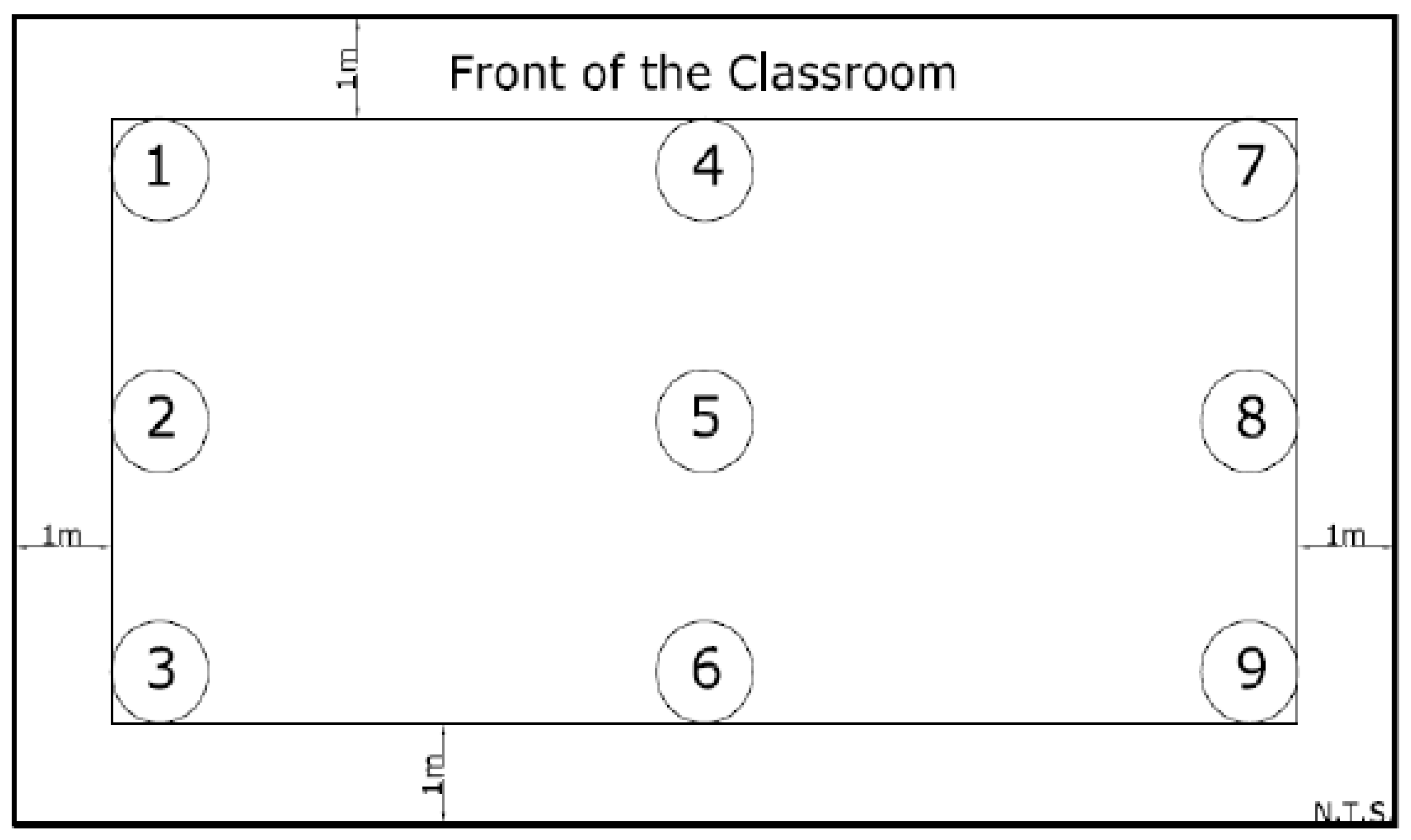
Appendix B. Questionnaire Results
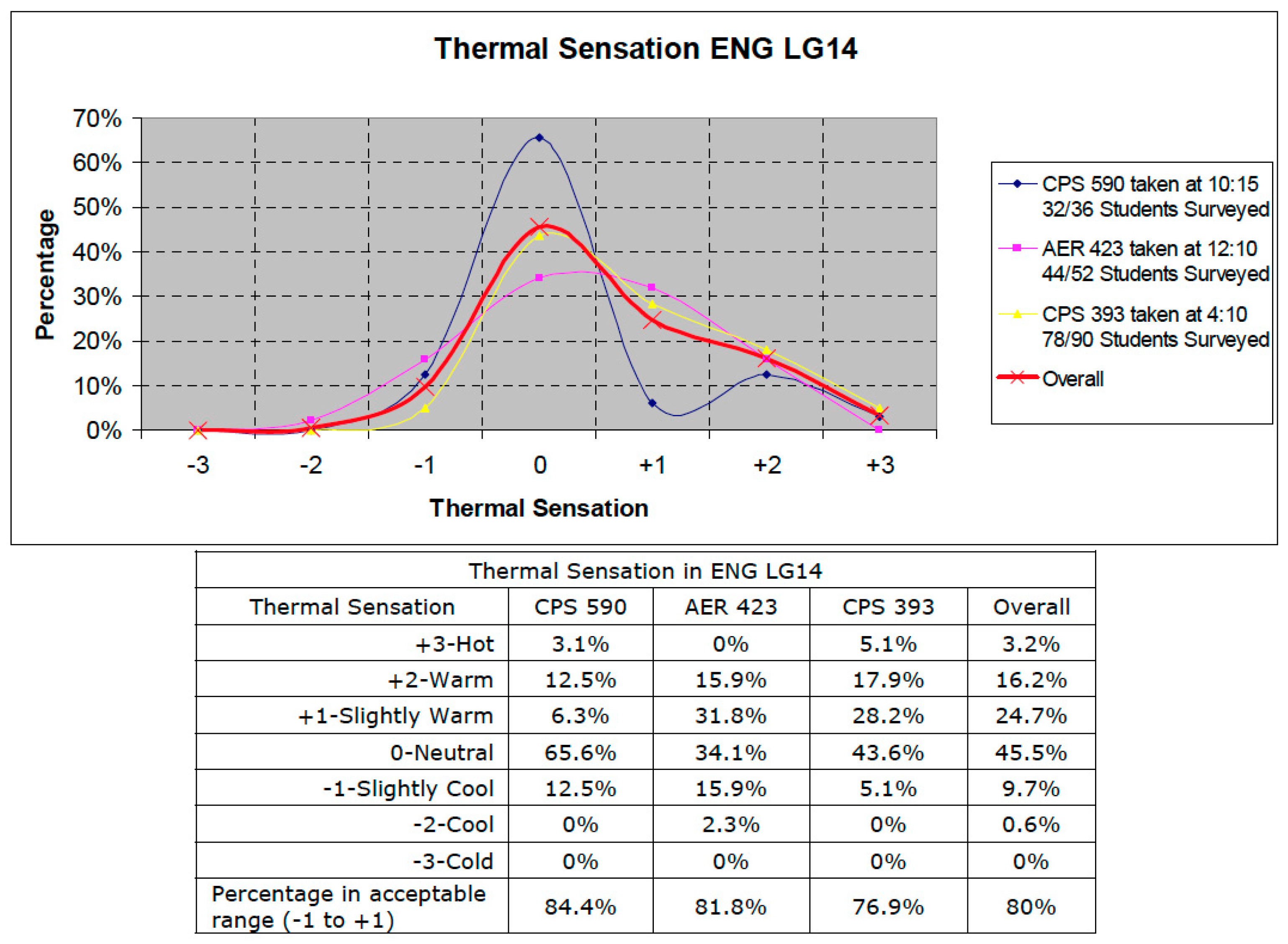
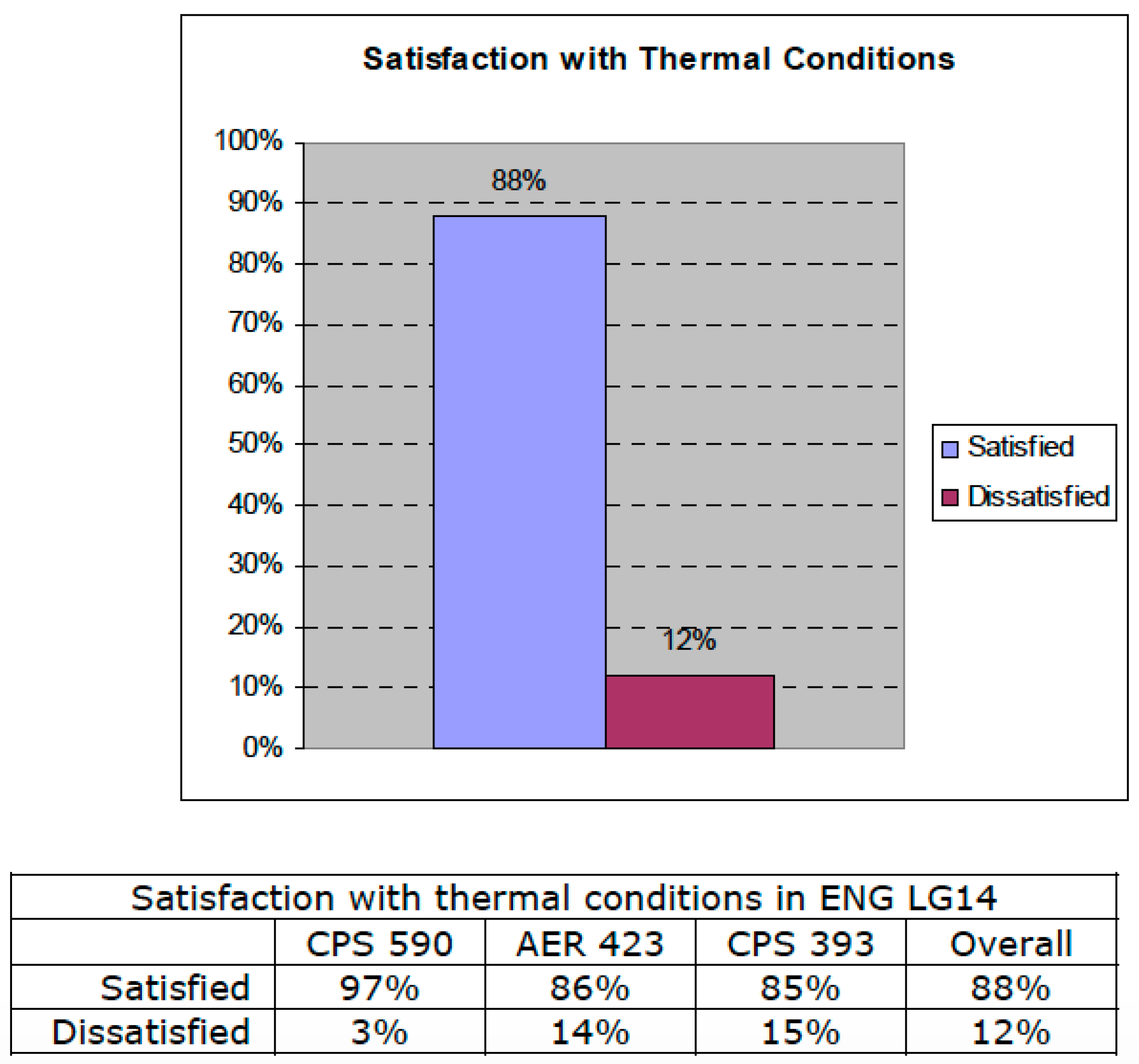
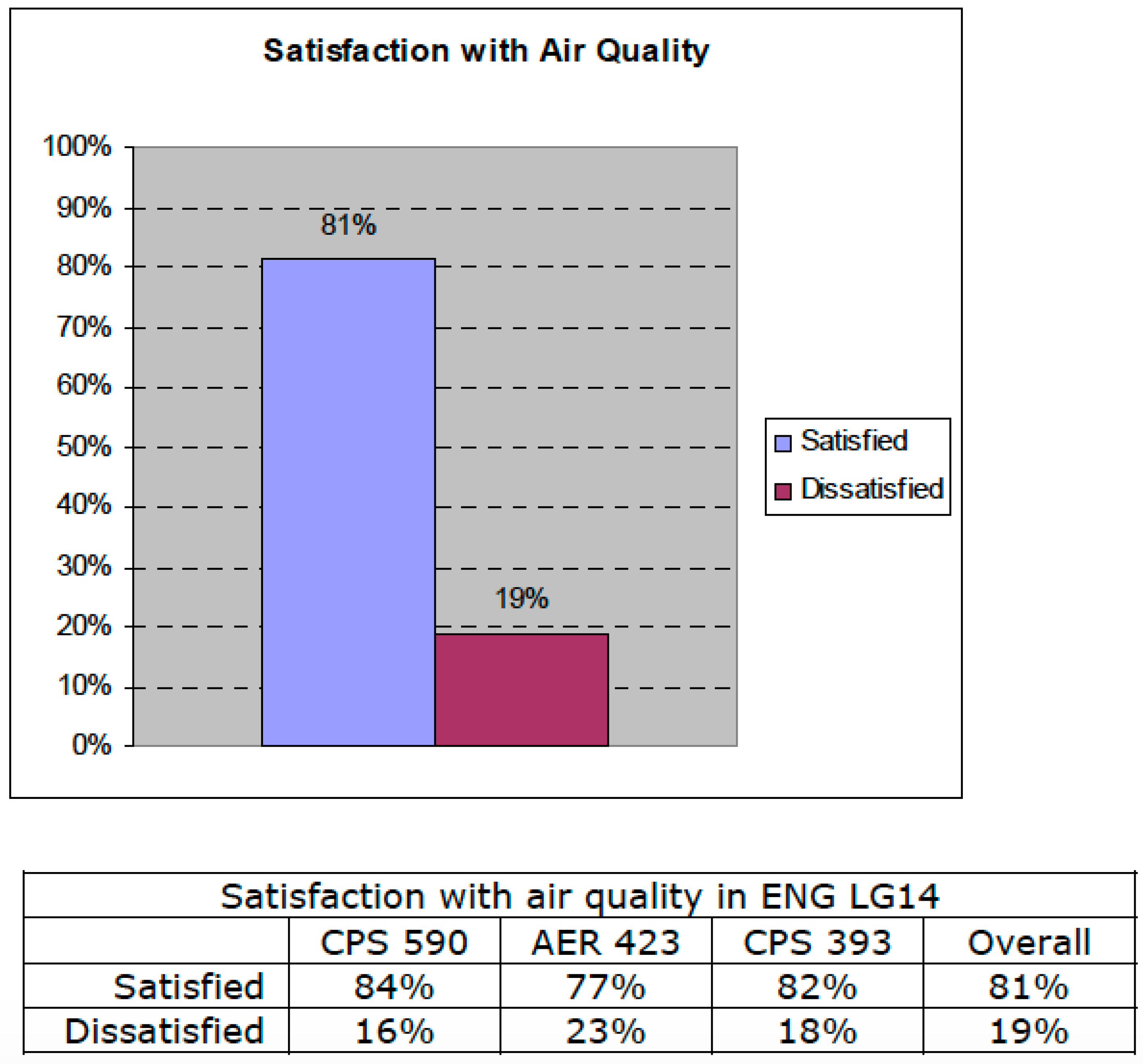
Appendix C. Classroom Lecture Schedules and Occupancy Pattern Input to Simulation
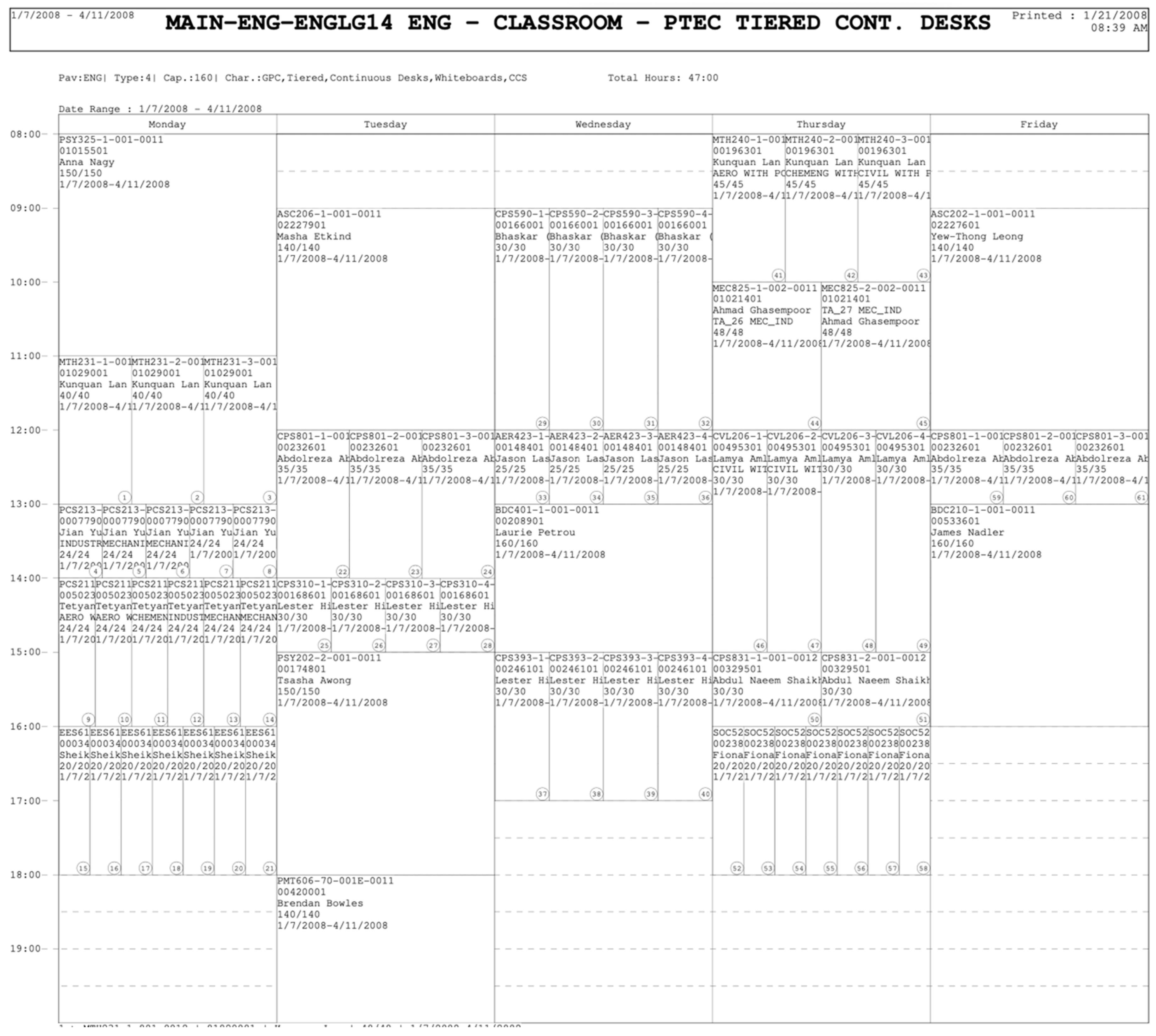
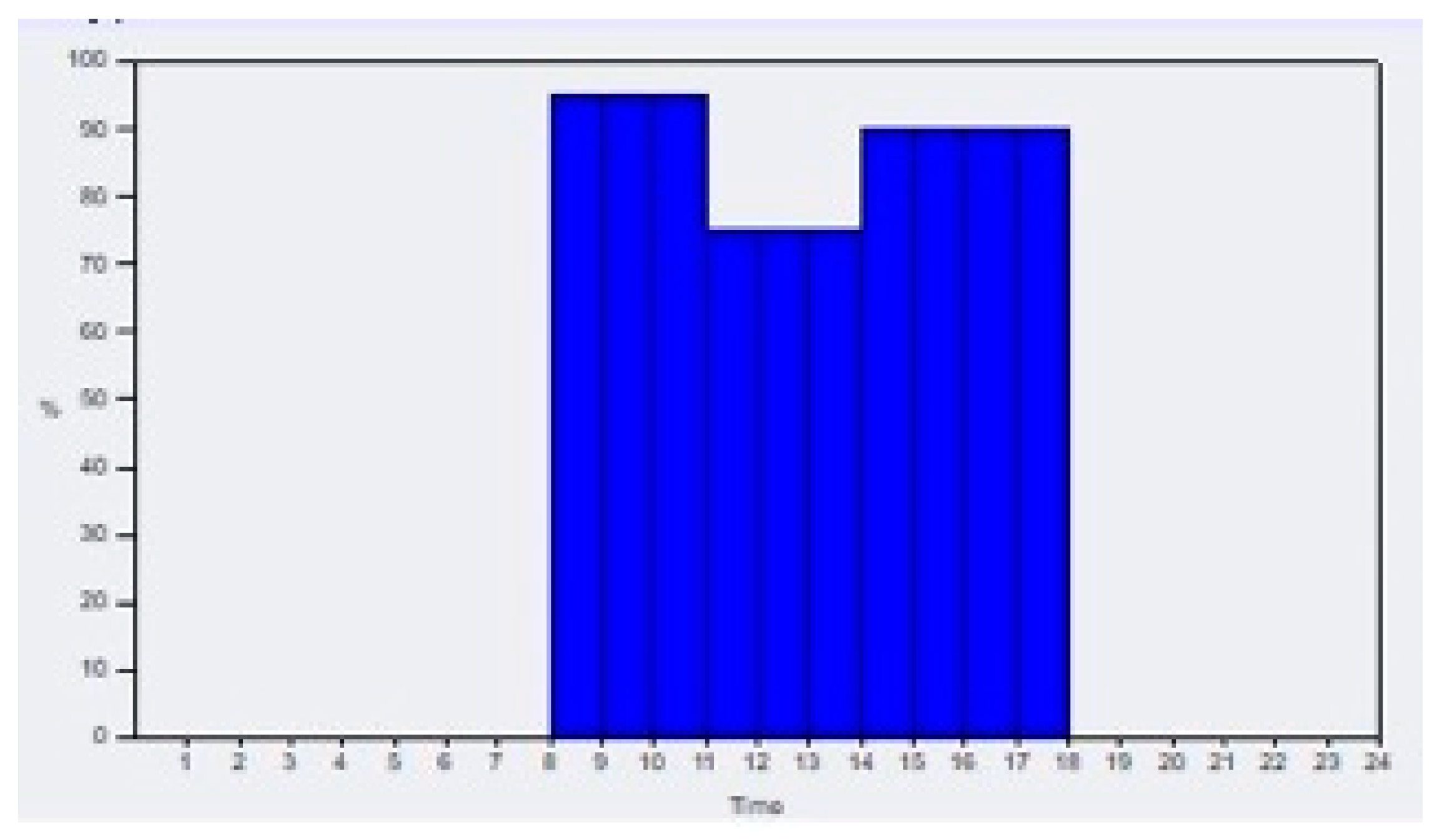

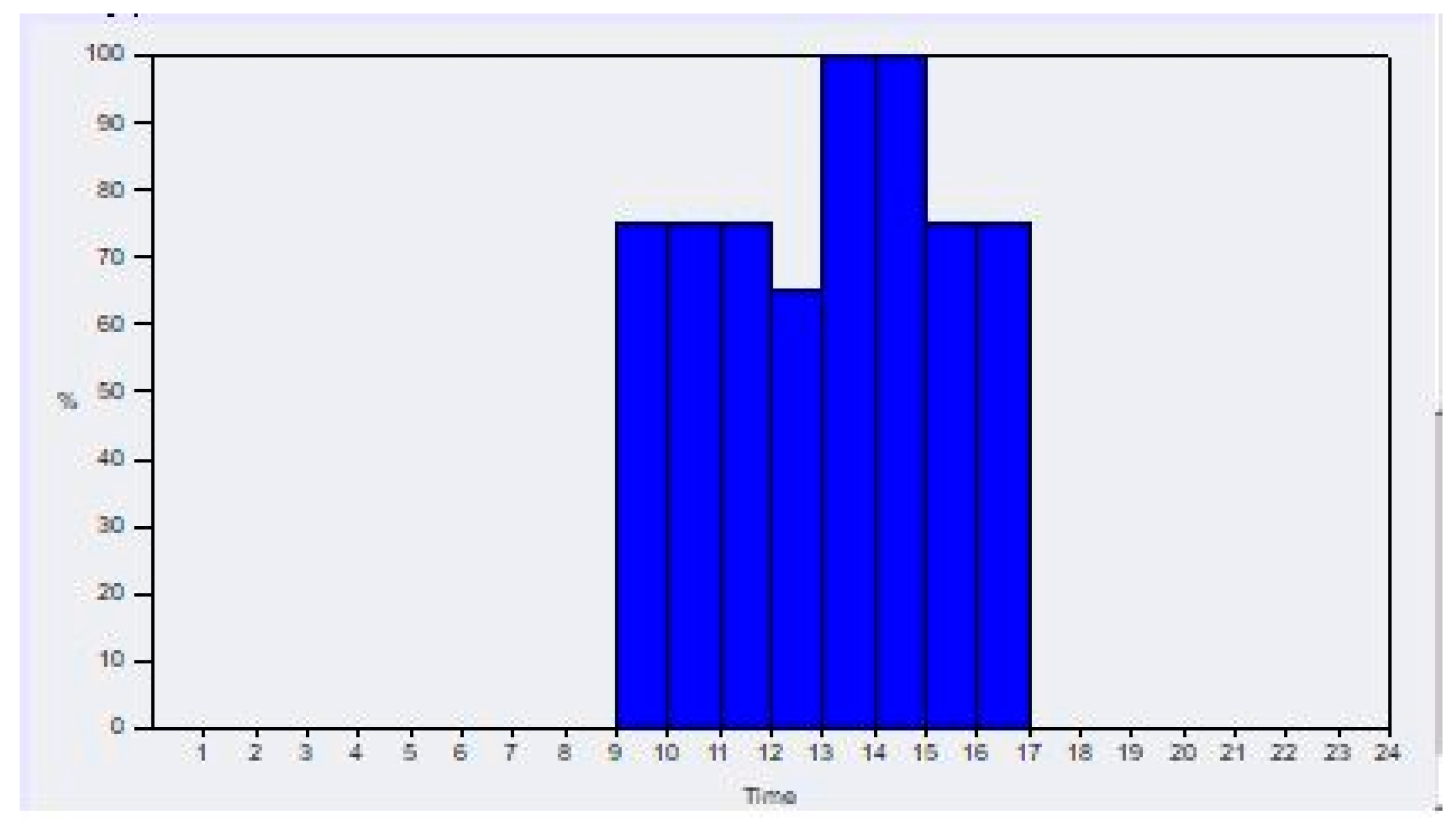
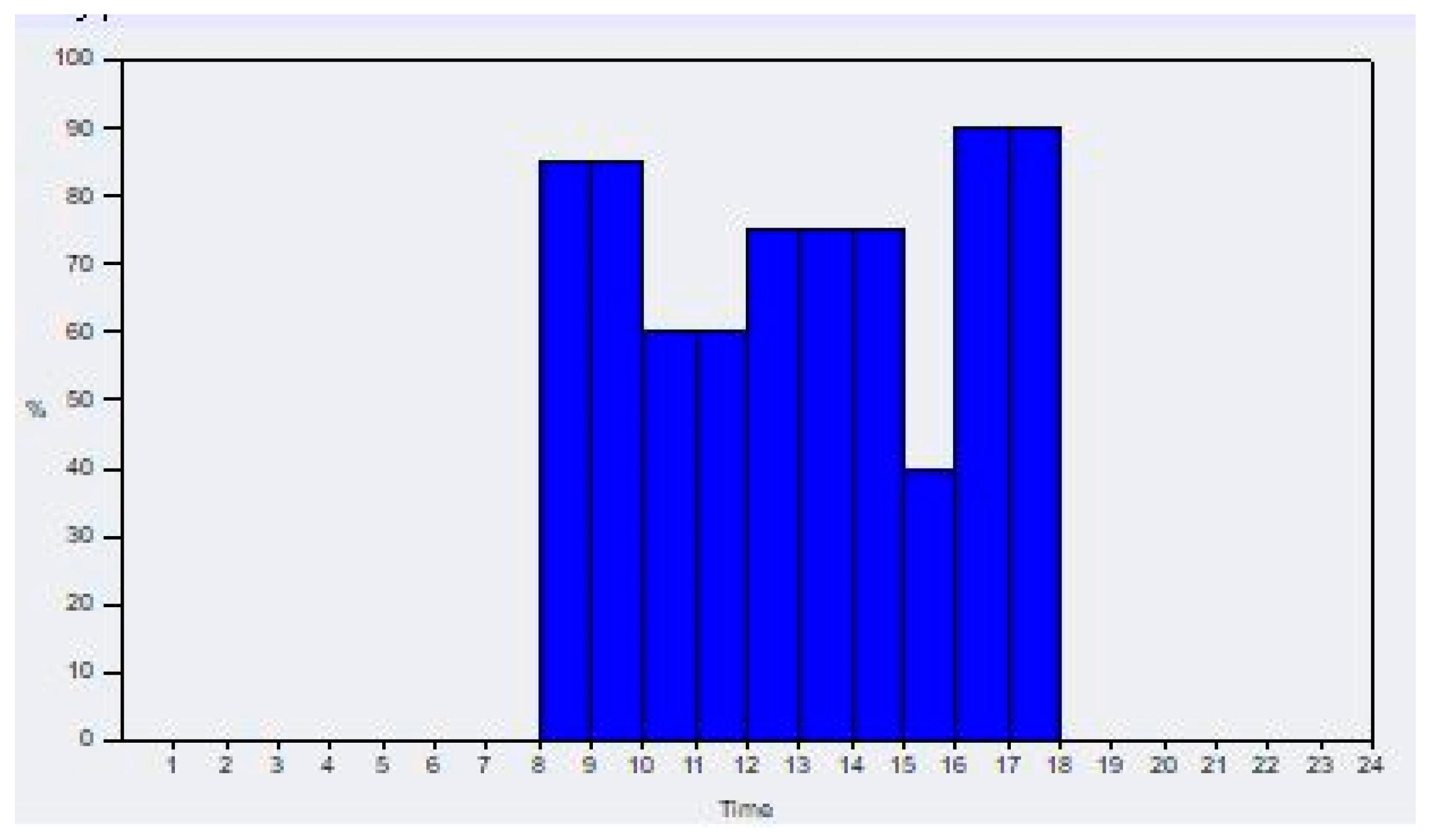
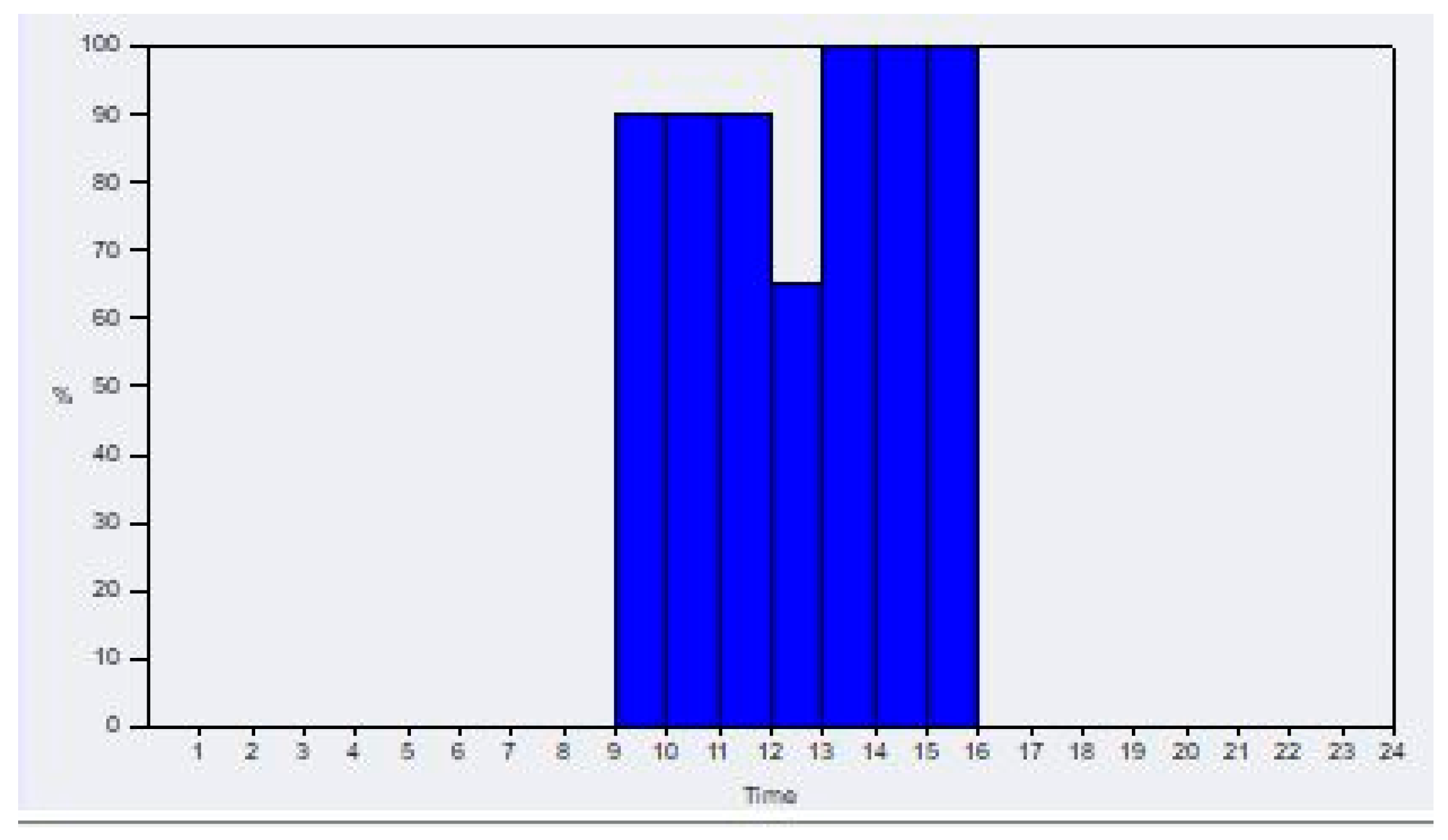
References
- ANSI/ASHRAE Addendum f to ANSI/ASHRAE Standard 62.1-2016. 2016. Available online: https://www.ashrae.org/File%20Library/Technical%20Resources/Standards%20and%20Guidelines/Standards%20Addenda/62.1-2016/62_1_2016_f_20180914.pdf (accessed on 7 July 2020).
- de Dear, R.J.; Akimoto, T.; Arens, E.A.; Brager, G.; Candido, C.; Cheong, K.W.D.; Li, B.; Nishihara, N.; Sekhar, S.C.; Tanabe, S.; et al. Progress in thermal comfort research over the last twenty years. Indoor Air 2013, 23, 442–461. [Google Scholar] [CrossRef] [PubMed]
- Leaman, A.; Bordass, B. Productivity in buildings: The ‘killer’ variables. Build. Res. Inf. 1999, 27, 4–19. [Google Scholar] [CrossRef]
- Mudarri, D.H. Potential correction factors for interpreting CO2 measurements in buildings. ASHRAE Trans. 1997, 103, 244. [Google Scholar]
- Persily, A.; de Jonge, L. Carbon dioxide generation rates for building occupants. Indoor Air 2017, 27, 868–879. [Google Scholar] [CrossRef] [PubMed]
- Rodero, A.; Krawczyk, D.A. Method for estimation of CO2 gains from persons in buildings. Proceedings 2018, 2, 1309. [Google Scholar] [CrossRef]
- Ahmed, K.; Kurnitski, J.; Olesen, B. Data for occupancy internal heat gain calculation in main building categories. Data Br. 2017, 15, 1030–1034. [Google Scholar] [CrossRef]
- Canada Health and Welfare. Exposure Guideline for Non-Residential Indoor Air Quality. 1987. Available online: https://www.toalltech.com/wp-content/themes/alltech/images/air_quality.pdf (accessed on 7 July 2020).
- ASHRAE. ANSI/ASHRAE Standard 62.1-2019 Ventilation for Acceptable Indoor Air Quality; American Society of Heating, Refrigerating, and Air-Conditioning Engineers, Inc.: Atlanta, GA, USA, 2019. [Google Scholar]
- ASHRAE. ASHRAE/ANSI Standard 55-2017 Thermal Environmental Conditions for Human Occupancy; American Society of Heating, Refrigerating, and Air-Conditioning Engineers: Atlanta, GA, USA, 2017. [Google Scholar]
- Kleiminger, W.; Santini, S.; Mattern, F. Smart heating control with occupancy prediction: How much can one save? In Proceedings of the 2014 ACM International Joint Conference on Pervasive and Ubiquitous Computing, Adjunct Publication, WA, USA, 13 September 2014; pp. 947–954. [Google Scholar]
- Krawczyk, D.A.; Rodero, A.; Gładyszewska-Fiedoruk, K.; Gajewski, A. CO2 concentration in naturally ventilated classrooms located in different climates—Measurements and simulations. Energy Build. 2016, 129, 491–498. [Google Scholar] [CrossRef]
- de Abreu-Harbich, L.V.; Chaves, V.L.A.; Brandstetter, M.C.G.O. Evaluation of strategies that improve the thermal comfort and energy saving of a classroom of an institutional building in a tropical climate. Build. Environ. 2018, 135, 257–268. [Google Scholar] [CrossRef]
- Asif, A.; Zeeshan, M.; Jahanzaib, M. Indoor temperature, relative humidity and CO2 levels assessment in academic buildings with different heating, ventilation and air-conditioning systems. Build. Environ. 2018, 133, 83–90. [Google Scholar] [CrossRef]
- Zomorodian, Z.S.; Tahsildoost, M.; Hafezi, M. Thermal comfort in educational buildings: A review article. Renew. Sustain. Energy Rev. 2016, 59, 895–906. [Google Scholar] [CrossRef]
- Theodosiou, T.G.; Ordoumpozanis, K.T. Energy, comfort and indoor air quality in nursery and elementary school buildings in the cold climatic zone of Greece. Energy Build. 2008, 40, 2207–2214. [Google Scholar] [CrossRef]
- Allab, Y.; Pellegrino, M.; Guo, X.; Nefzaoui, E.; Kindinis, A. Energy and comfort assessment in educational building: Case study in a French university campus. Energy Build. 2017, 143, 202–219. [Google Scholar] [CrossRef]
- Singh, M.K.; Ooka, R.; Rijal, H.B. Thermal comfort in Classrooms: A critical review. In Proceedings of the 10th Windsor Conference 2018—Rethinking Comfort, Windsor, UK, 12–15 April 2018; Cumberland Lodge: Windsor, UK, 2018; pp. 649–668. [Google Scholar]
- Cao, B.; Zhu, Y.; Ouyang, Q.; Zhou, X.; Huang, L. Field study of human thermal comfort and thermal adaptability during the summer and winter in Beijing. Energy Build. 2011, 43, 1051–1056. [Google Scholar] [CrossRef]
- Wang, Z.; Li, A.; Ren, J.; He, Y. Thermal adaptation and thermal environment in university classrooms and offices in Harbin. Energy Build. 2014, 77, 192–196. [Google Scholar] [CrossRef]
- Cheng, M.J.; Hwang, R.L.; Lin, T.P. Field experiments on thermal comfort requirements for campus dormitories in Taiwan. Indoor Built Environ. 2008, 17, 191–202. [Google Scholar] [CrossRef]
- Wang, Z.; Ning, H.; Zhang, X.; Ji, Y. Human thermal adaptation based on university students in China’s severe cold area. Sci. Technol. Built Environ. 2017, 23, 413–420. [Google Scholar] [CrossRef]
- Seppänen, O.; Fisk, W.; Lei, Q. Effect of Temperature on Task Performance in Office Environment; Ernest Orlando Lawrence Berkeley National Laboratory: Berkeley, CA, USA, 2006; p. 11. [Google Scholar]
- Chatzidiakou, L.; Mumovic, D.; Summerfield, A. Is CO2 a good proxy for indoor air quality in classrooms? Part 1: The interrelationships between thermal conditions, CO2 levels, ventilation rates and selected indoor pollutants. Build. Serv. Eng. Res. Technol. 2015, 36, 129–161. [Google Scholar] [CrossRef]
- Satish, U.; Mendell, M.J.; Shekhar, K.; Hotchi, T.; Sullivan, D.; Streufert, S.; Fisk, W.J. Is CO2 an indoor pollutant? direct effects of low-to-moderate CO2 concentrations on human decision-making performance. Environ. Health Perspect. 2012, 120, 1671–1677. [Google Scholar] [CrossRef]
- Dorizas, P.V.; Assimakopoulos, M.; Santamouris, M.; Sifnaios, J.; Stathi, K. Does indoor environmental quality affect students performance? In Proceedings of the 34th AIVC-3rd TightVent-2nd Cool Roofs’-1st Venticool Conference, Athens, Greece, 25–26 September 2013. [Google Scholar]
- Jaakkola, J.J.K.; Heinonen, O.P.; Seppanen, O. Mechanical ventilation in office buildings and the sick building syndrome: An experimental and epidemiological study. Indoor Air 1991, 1, 111–121. [Google Scholar] [CrossRef]
- Norback, D.; Michel, I.; Widstrom, J. Indoor air quality and personal factors related to the sick building syndrome. Scand. J. Work Environ. Health 1990, 16, 121–128. [Google Scholar] [CrossRef] [PubMed]
- Schibuola, L.; Scarpa, M.; Tambani, C. CO2 based ventilation control in energy retrofit: An experimental assessment. Energy 2018, 143, 606–614. [Google Scholar] [CrossRef]
- Boudier, K.; Fiorentini, M.; Hoffmann, S.; Kalyanam, R.; Kokogiannakis, G. Coupling a Thermal Comfort Model with Building Simulation for User Comfort and Energy Efficiency. In CESBP Central European Symposium on Building Physics/BauSIM; University of Wollongong: Wollongong, Australia, 2016. [Google Scholar]
- Wang, Y.; Kuckelkorn, J.; Zhao, F.Y.; Liu, D.; Kirschbaum, A.; Zhang, J.L. Evaluation on classroom thermal comfort and energy performance of passive school building by optimizing HVAC control systems. Build. Environ. 2015, 89, 86–106. [Google Scholar] [CrossRef]
- Saleem, A.A.; Abel-Rahman, A.K.; Ali, A.H.H.; Ookawara, S. An analysis of thermal comfort and energy consumption within public primary schools in Egypt. IAFOR J. Sustain. Energy Environ. 2016, 3. [Google Scholar] [CrossRef]
- Hong, T. EnergyPlus Analysis Capabilities for Use in California Building Energy Efficiency Standards Development and Compliance Calculations; 822E; Lawrence Berkeley National Lab (LBNL): Berkeley, CA, USA, 2009; pp. 1–30. [Google Scholar]
- U.S. Department of Energy’s (DOE) Building Technologies Office. Weather Data by Location- EnergyPlus. Available online: https://energyplus.net/weather-location/north_and_central_america_wmo_region_4/CAN/ON/CAN_ON_Toronto.716240_CWEC (accessed on 4 November 2019).
- The Ontario Building Code Design Indoor Air Temperatures. Available online: http://www.buildingcode.online/816.html (accessed on 5 November 2019).
- Matutinovic, L. Using calibrated energy models to help understand, manage and improve existing building energy performance. ESIM 2014 Biannu. Conf. IBPSA-Canada Proc. 2014. Available online: http://www.ibpsa.org/proceedings/eSimPapers/2014/8A.3.pdf (accessed on 7 July 2020).
- Gao, J.; Wargocki, P.; Wang, Y. Indoor air quality and thermal environment in classrooms with different ventilation systems. REHVA J. 2014, 51, 10–14. [Google Scholar]
- USACE CECW Pamphlet-Construction Quality Assurance Representative’s Guide Volume 6: Building Envelopes Foreword; Department of the Army Corps of Engineers: Washington, DC, USA, 2016. Available online: https://www.publications.usace.army.mil/Portals/76/Publications/EngineerPamphlets/EP_415-1-261%20Vol-06.pdf?ver=2016-05-19-145012-860 (accessed on 7 July 2020).
- Erickson, V.L.; Carreira-Perpiñán, M.Á.; Cerpa, A.E. Occupancy-based system for efficient reduction of HVAC energy. In Proceedings of the 10th International Conference on Information Processing in Sensor Networks, IPSN’11, Chicago, IL, USA, 12–14 April 2011; pp. 258–269. [Google Scholar]
- Swaminathan, S.; Wang, X.; Zhou, B.; Baldi, S. A university building test case for occupancy-based building automation. Energies 2018, 11, 3145. [Google Scholar] [CrossRef]
- Dong, J.; Winstead, C.; Nutaro, J.; Kuruganti, T. Occupancy-based HVAC control with short-term occupancy prediction algorithms for energy-efficient buildings. Energies 2018, 11, 2427. [Google Scholar] [CrossRef]
- Rafsanjani, H.N.; Ahn, C.R.; Alahmad, M. A review of approaches for sensing, understanding, and improving occupancy-related energy-use behaviors in commercial buildings. Energies 2015, 8, 10996–11029. [Google Scholar] [CrossRef]
- Hong, T.; Kim, C.J.; Jeong, J.; Kim, J.; Koo, C.; Jeong, K.; Lee, M. Framework for approaching the minimum CV(RMSE) using energy simulation and optimization tool. Energy Procedia 2016, 88, 265–270. [Google Scholar] [CrossRef]
- Roberts, B.M.; Allinson, D.; Diamond, S.; Abel, B.; Bhaumik, C.D.; Khatami, N.; Lomas, K.J. Predictions of summertime overheating: Comparison of dynamic thermal models and measurements in synthetically occupied test houses. Build. Serv. Eng. Res. Technol. 2019, 40, 512–552. [Google Scholar] [CrossRef]
- Reddy, D. Use of Energy and Other Monitored Data to Calibrate a Whole Building Energy Model. Doctoral Dissertation, University of Washington, Seattle, WA, USA, 2013. [Google Scholar]
- Rallapalli, H.S. A Comparison of Energyplus and eQUEST Whole Building Energy Simulation Results for a Medium Sized Office Building. Doctoral Dissertation, Arizona State University, Tempe, AZ, USA, 2010. [Google Scholar]
- Zerroug, A.; Eglis, D. Analysis of results of energy consumption simulation With Equest and Energyplus. In Proceedings of the International Conference Civil Engineering. 2011, pp. 102–107. Available online: https://llufb.llu.lv/conference/Civil_engineering/2015/Latvia_CivilEngineering2015Vol5-102-107.pdf (accessed on 7 July 2020).
- Natural Resources Canada (NRCAN). Survey 2000, Commercial and Institutional Building Energy Use—Summary Report. August 2003. Available online: https://oee.nrcan.gc.ca/publications/statistics/scieu/2009/pdf/SCIEU2009Establishments.pdf (accessed on 7 July 2020).
- Ahmad, M.W.; Hippolyte, J.; Reynolds, J.; Mourshed, M.; Rezgui, Y. Optimal scheduling strategy for enhancing IAQ, thermal comfort and visual using a genetic algorithm. In Proceedings of the ASHRAE IAQ 2016, Alexandria, VA, USA, 12–14 September 2016. [Google Scholar]
- Chenari, B.; Lamas, F.B.; Gaspar, A.R.; da Silva, M.G. Simulation of occupancy and CO2-based demand-controlled mechanical ventilation strategies in an office room using EnergyPlus. Energy Procedia 2017, 113, 51–57. [Google Scholar] [CrossRef]
- Hong, T.; Langevin, J.; Sun, K. Building simulation: Ten challenges. Build. Simul. 2018, 11, 871–898. [Google Scholar] [CrossRef]


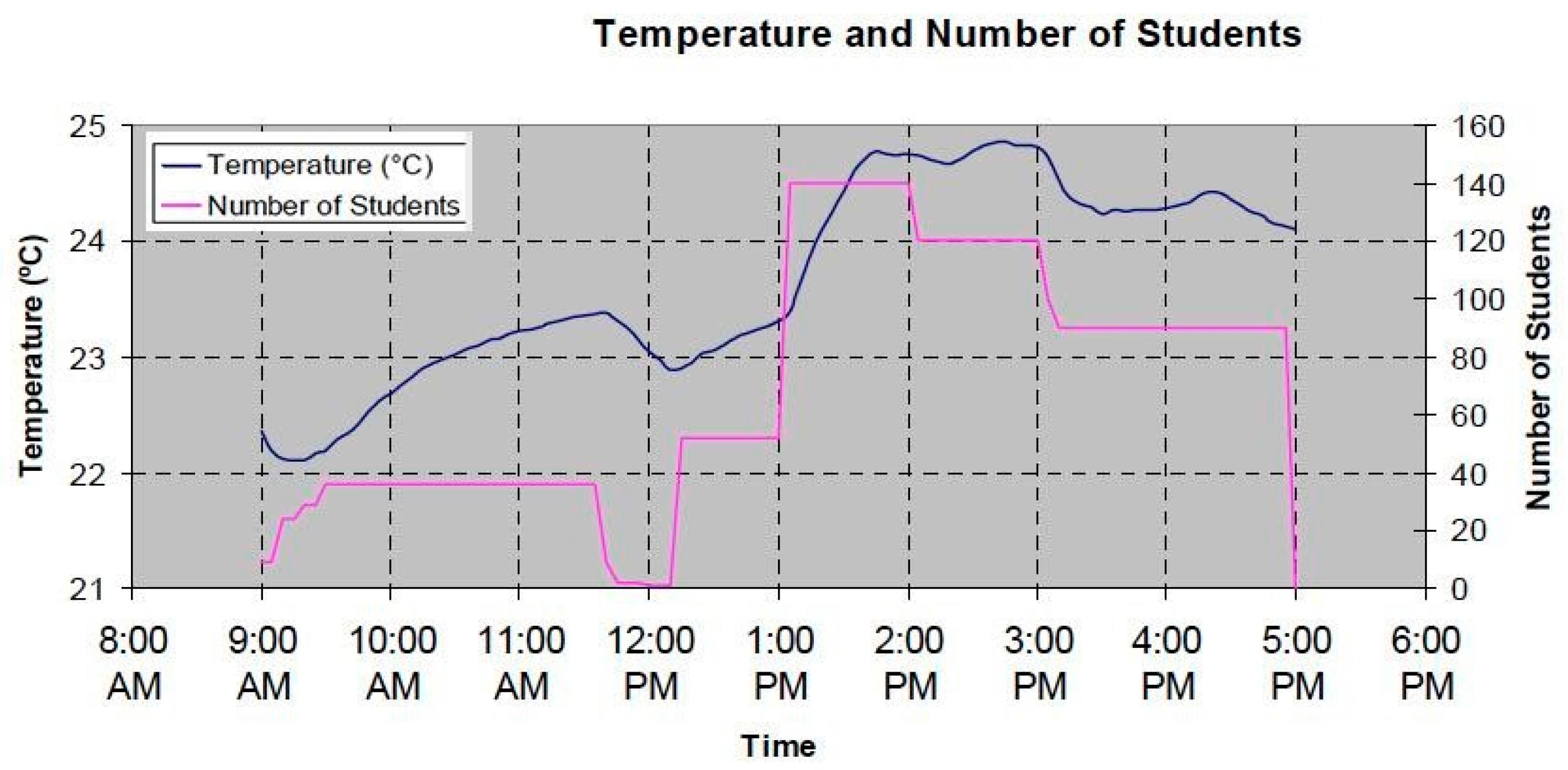
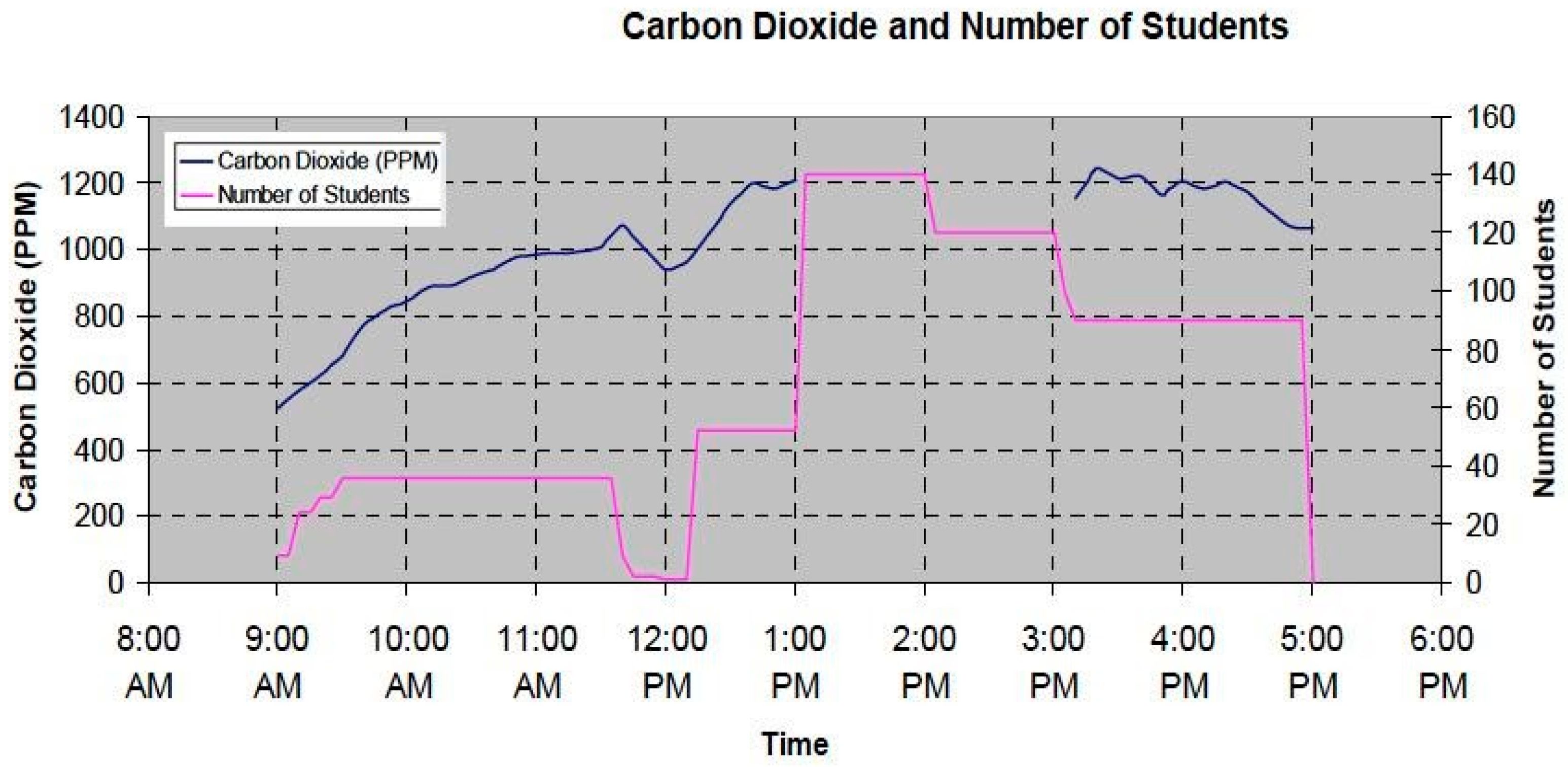
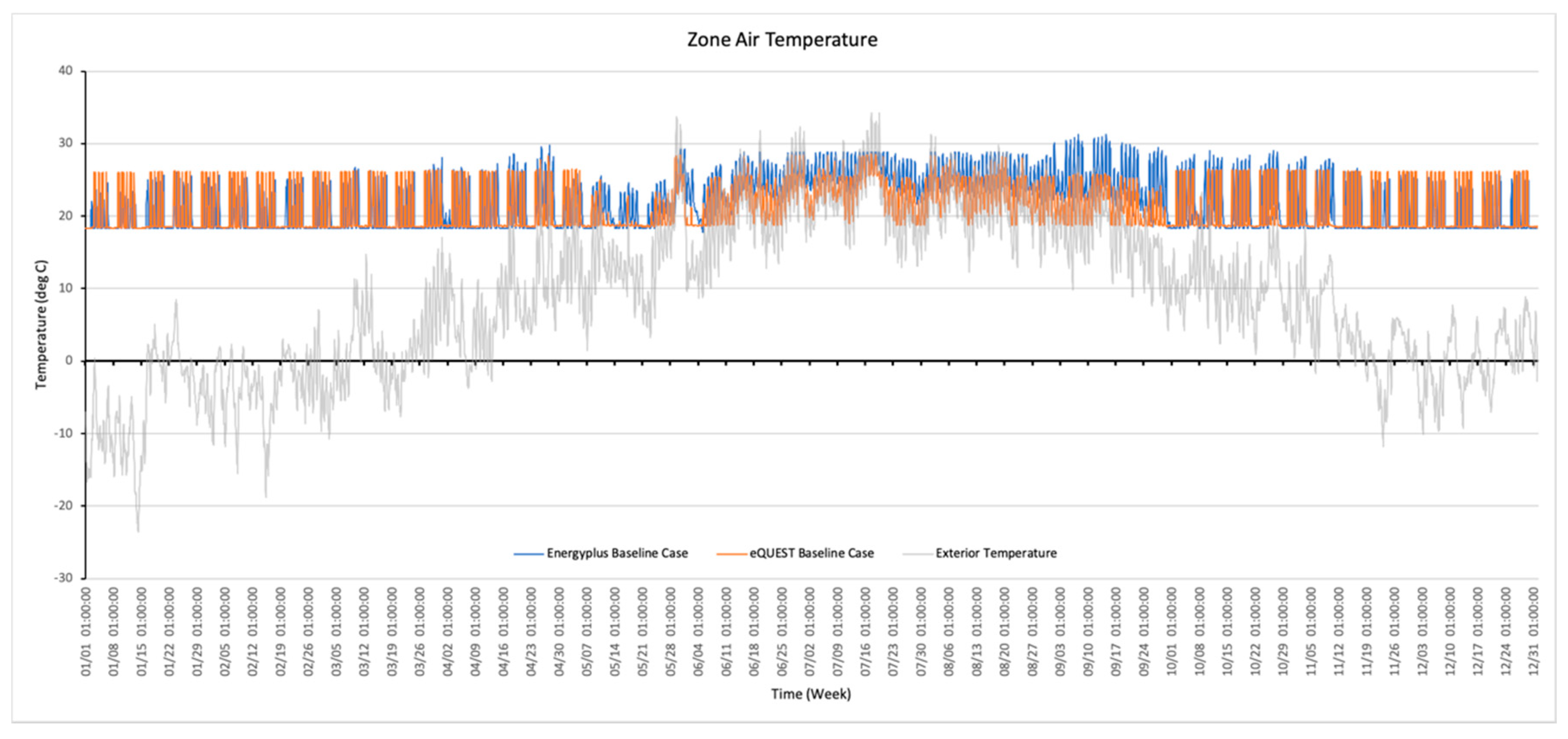
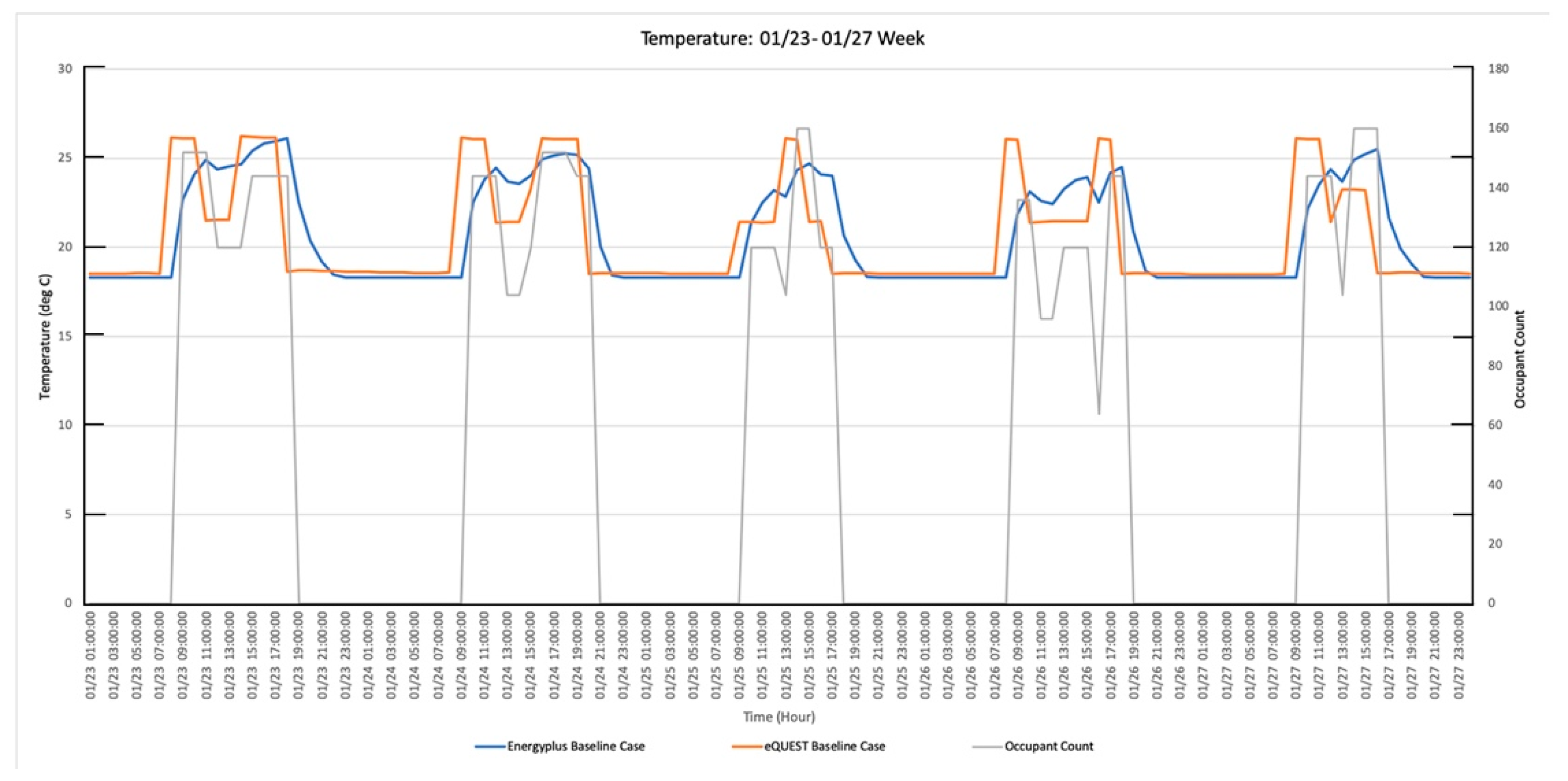
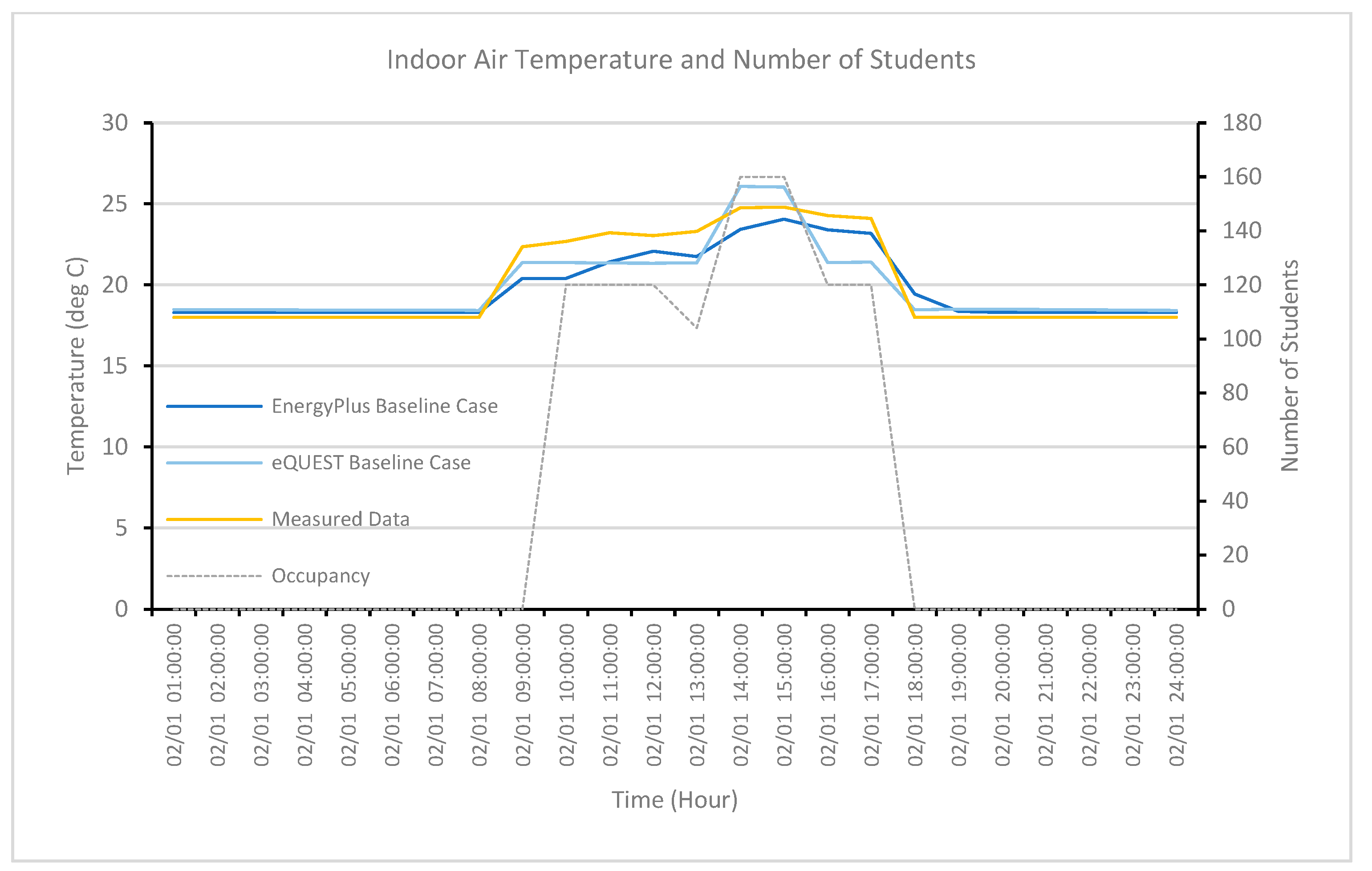
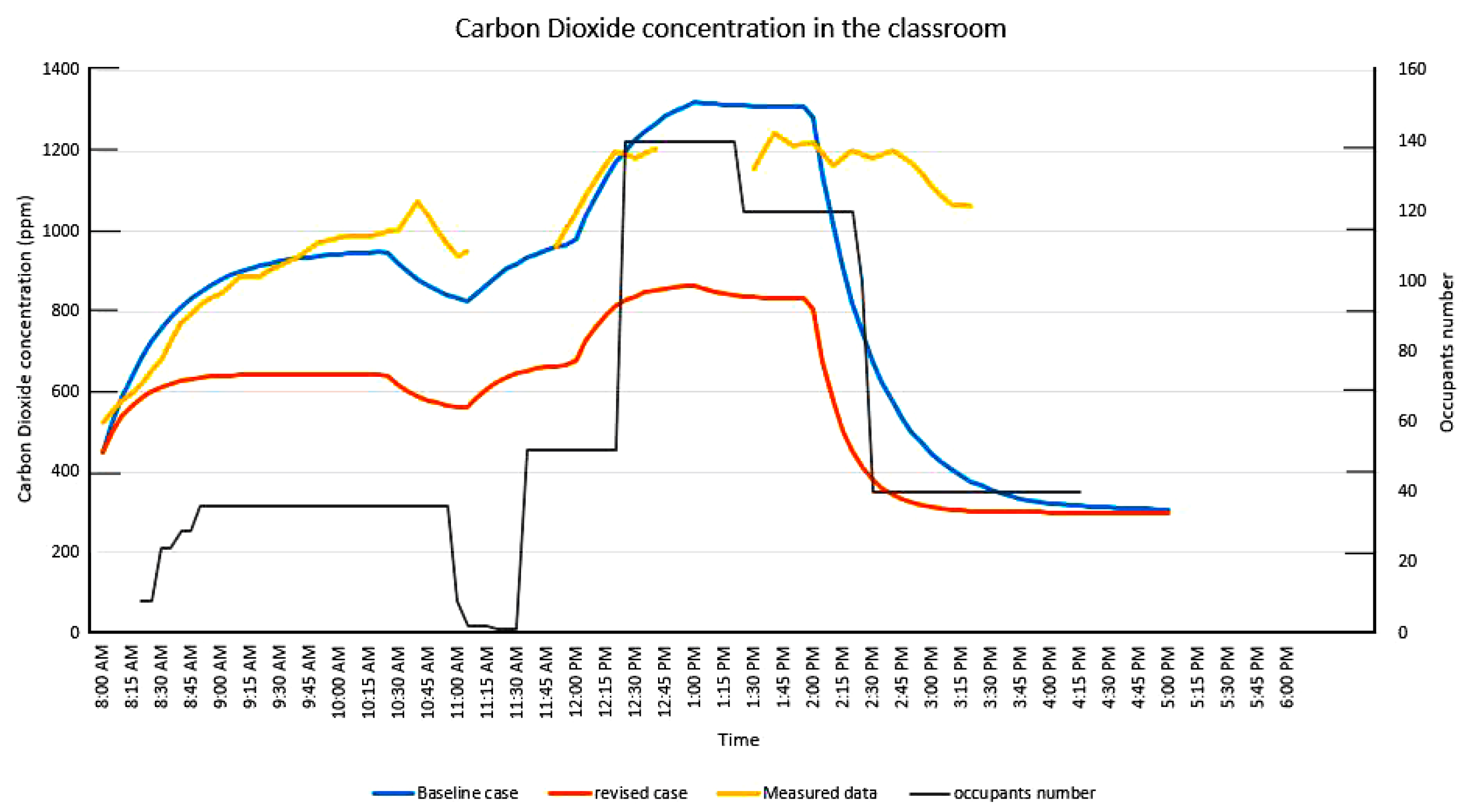
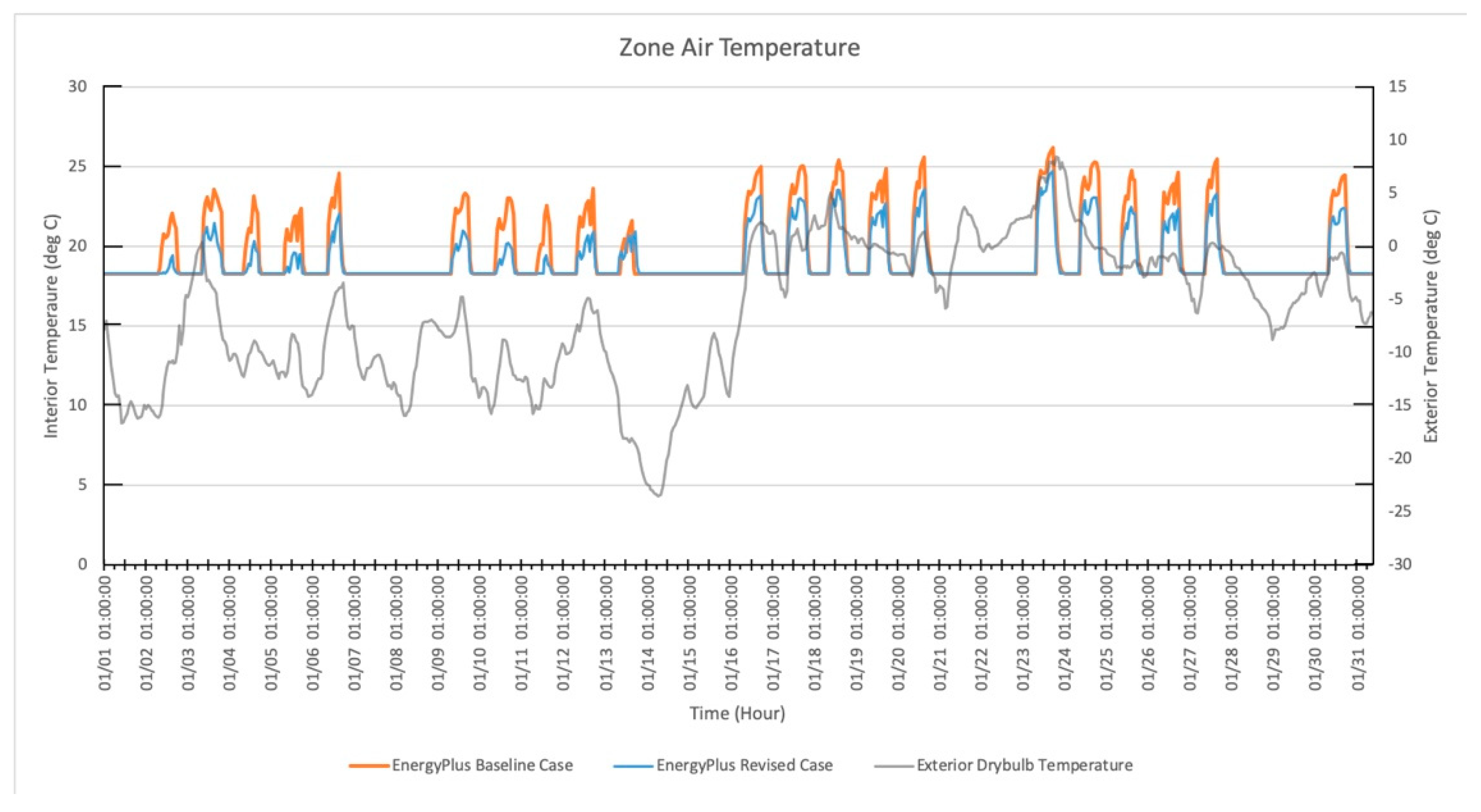
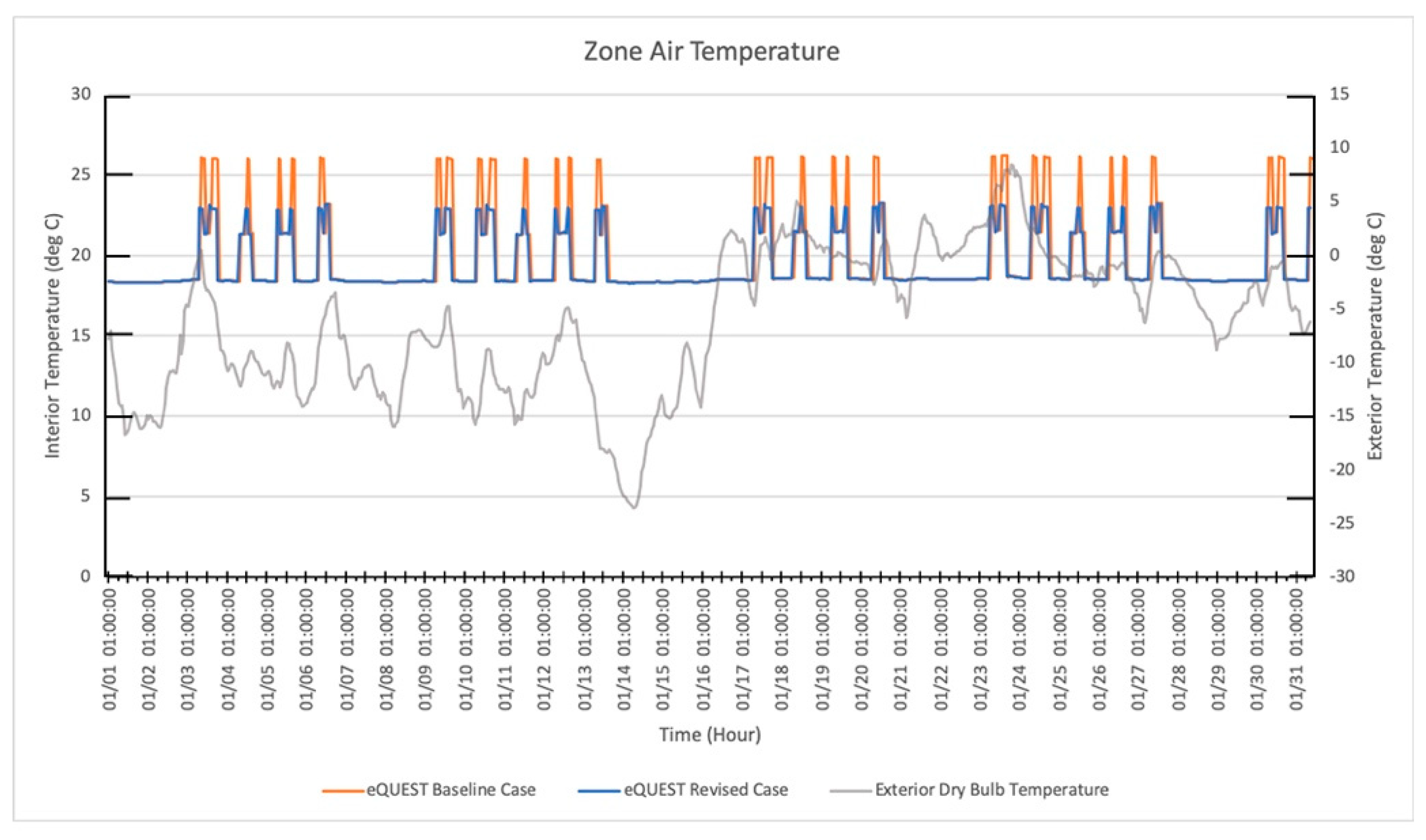
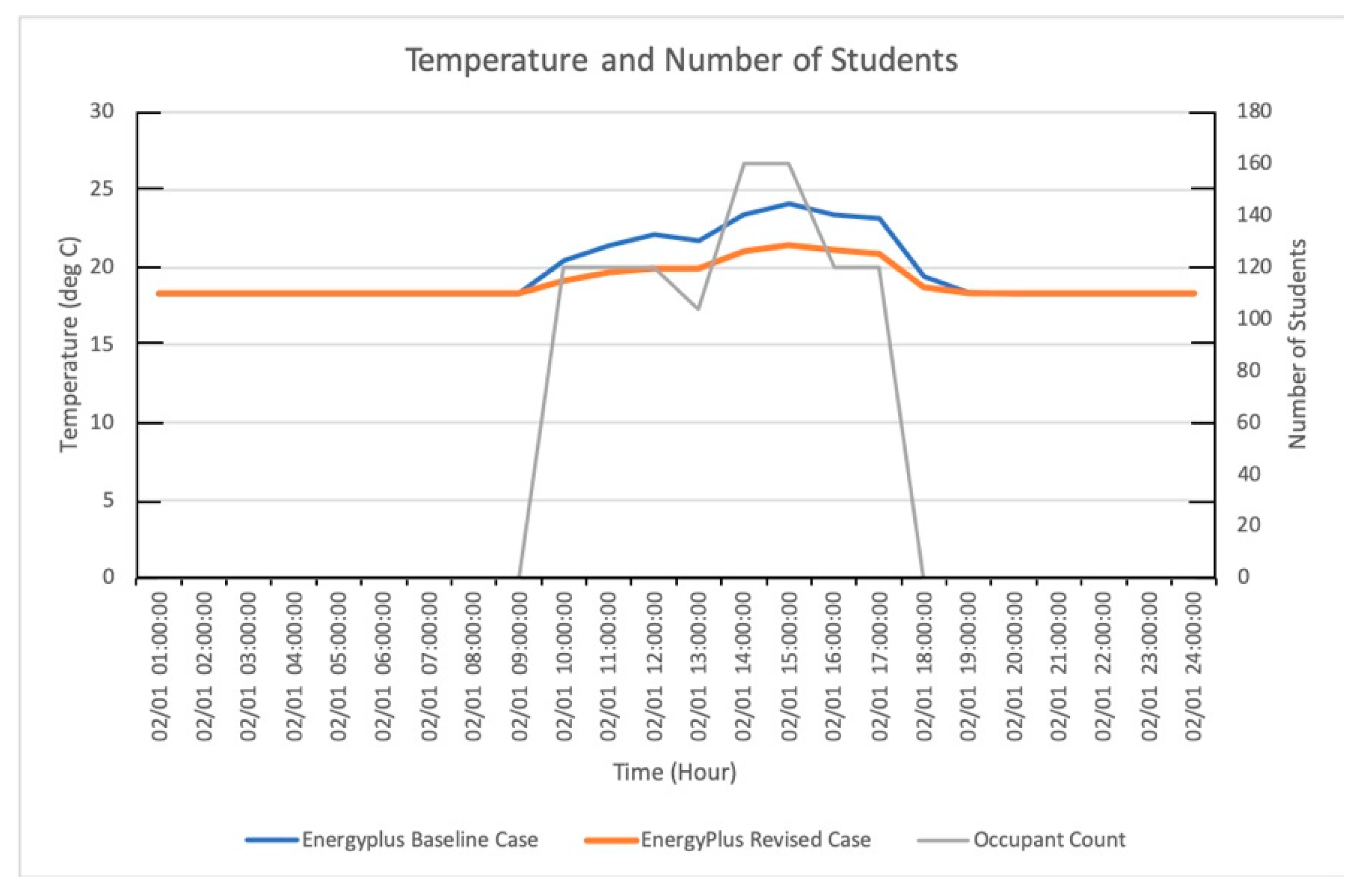
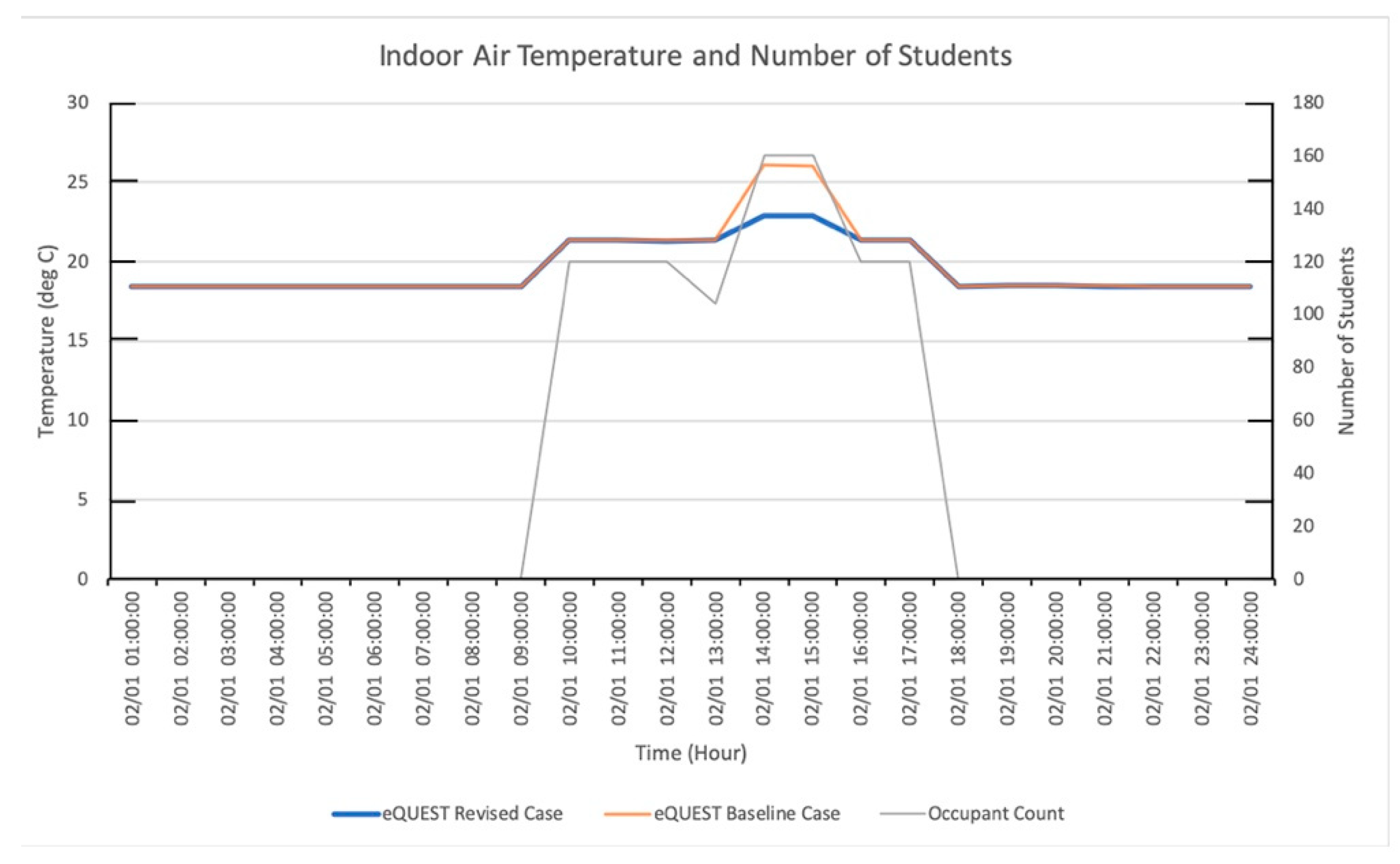
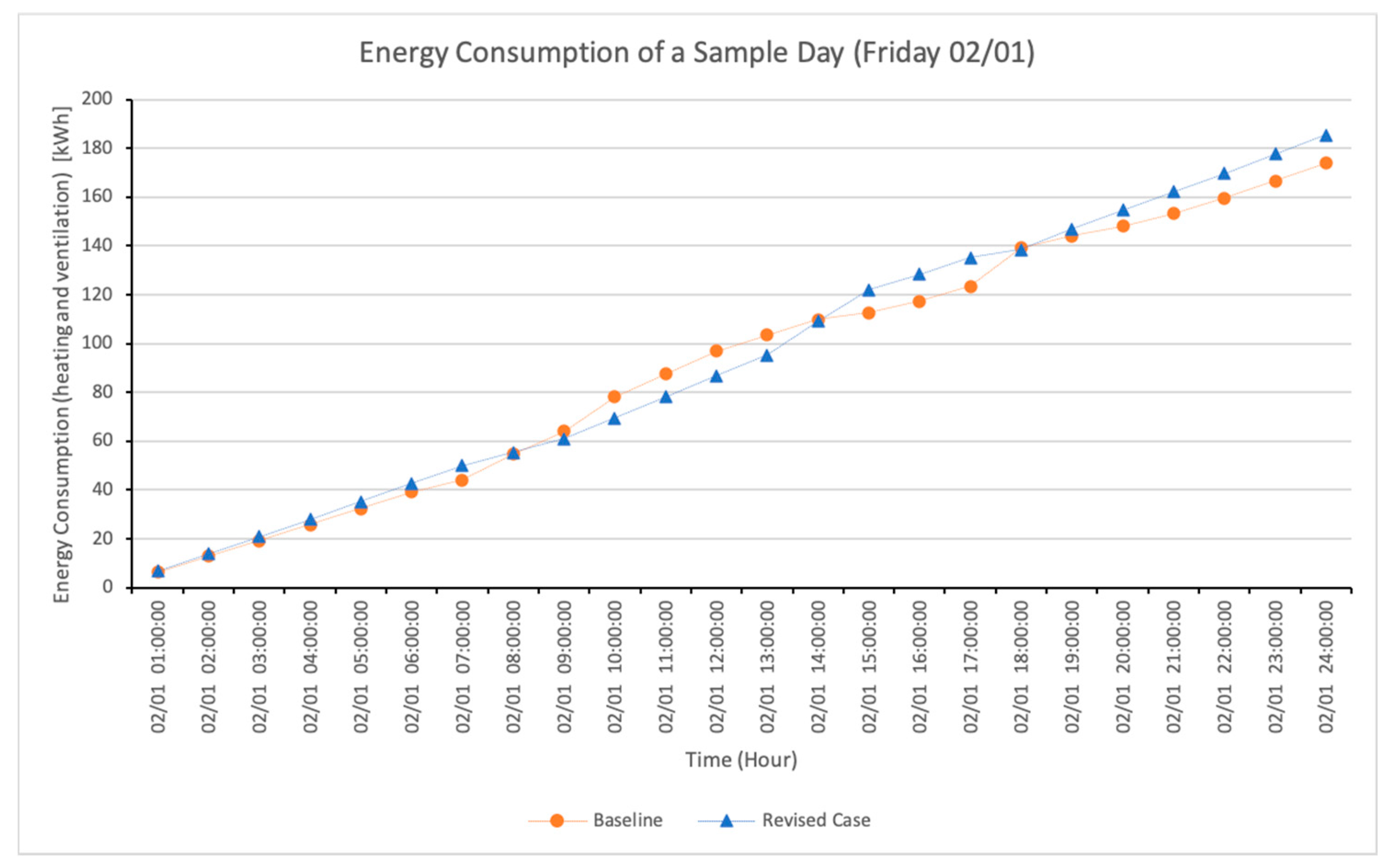
| Contaminant | Health and Welfare Canada [8] Industrial Buildings and Non-Industrial Buildings | American Society of Heating, Refrigerating and Air Conditioning ASHRAE 62 [9] ASHRAE 55 [10] | Mitigative Measures | |
|---|---|---|---|---|
| Average Concentration (mg/m3) | Maximum Allowable Concentration (mg/m3) | Ventilation and Room Requirements | ||
| Outdoor air requirement for ventilation (l/s/person) | - | - | 10 | ventilation rate control |
| Temperature (°C) | - | - | 19.5–23 (Winter) 22.6–26 (Summer) | Control Heating, Ventilation, Air Conditioning (HVAC) heating and cooling system operation: Model Predictive Control [11] |
| Relative humidity (%) | - | - | 30–60% | Control HVAC heating and cooling system operation: Model Predictive Control [11] |
| NO2 | 9 | - | - | Increasing ventilation airflow rate to between 2.5 to 5 air changes per hour (ACH) [12] |
| CO | 55 | 440 | - | |
| CO2 | 9000 | 18,000 | - | |
| O3 | 0.2 | 0.6 | - | |
| Lead | 0.15 | 0.45 | - | |
| Chlordane | 0.5 | 2 | - | |
| Parameters | Input Values |
|---|---|
| Layout/Geometry |
|
| Occupancy |
|
| Metabolic |
|
| Heating/Cooling Setpoint Temperature |
|
| Construction (EnergyPlus) |
|
| Construction (eQUEST) |
|
| HVAC System |
|
| Variables | Baseline Case | Revised Case 1-for Reducing CO2 | Revised Case 2-for Reducing Temperature |
|---|---|---|---|
| Outdoor Air Flow Rate ACH (#/hr) | 0.5 | 2.5 | 2.5 |
| Schedule | 100% operated | N/A | To minimize heating availability when full occupancy is expected, the following schedule is implemented for the occupancy-based pre-active control: |
| Occupancy: 100% Heating Availability *: 5% (close to off condition) | |||
| Occupancy: 90% Heating Availability: 10% | |||
| Occupancy: 80% Heating Availability: 15% | |||
| Occupancy: 70% Heating Availability: 20% | |||
| Occupancy: below 70% Heating: normal condition | |||
| According to Figure 3, overheating occurs when occupancy is above 70% of maximum room capacity, therefore the pre-active control is activated only when occupancy is above 70%. |
| Model Data | Root Mean Squared Error RMSE (°C) | Coefficient of Variation of Root Mean Squared Error CV-RMSE (%) |
|---|---|---|
| 1-EnergyPlus Results | 1.47 | 6.23 |
| 2-eQUEST Results | 1.88 | 7.95 |
| Baseline Case Building EUI | Revised Case 2 Building EUI-without Energy from Mech Vent. | Revised Case 2 Building EUI-with Energy from Mech Vent. | |
|---|---|---|---|
| EnergyPlus | 103.94 | 103.74 | 124.72 |
| eQUEST | 120.27 | 120.16 | 141.25 |
| Baseline Case Building EUI | Revised Case 2 Building EUI-without Energy from Mech Vent. | Revised Case 2 Building EUI-with Energy from Mech Vent. | |
|---|---|---|---|
| EnergyPlus | 87.66 | 82.69 | 109.56 |
| eQUEST | 128.79 | 126.63 | 149.16 |
| Control Strategy | Infiltration Rate ACH (#/hour) | Mechanical Ventilation ACH (#/hour) | Zone Air Maximum CO2 Concentration (ppm) | Zone Air Average CO2 Concentration (ppm) | Fan Energy Consumption (kWh/hour) |
|---|---|---|---|---|---|
| Baseline | 1.1 | 0.5 | 1320.45 | 818.18 | 0.009 |
| Revised | 1.1 | 2.5 | 864.06 | 573.68 | 0.047 |
| Control Strategy | Mechanical Ventilation ACH (#/hour) | Zone Air Maximum Temperature (°C) | Zone Air Average Temperature-Considering Occupied and Unoccupied Hours (°C) |
|---|---|---|---|
| Baseline (EP) | 0.5 | 24.06 | 19.73 |
| Baseline (EQ) | 26.07 | 19.82 | |
| Revised (EP) | 2.5 | 21.46 | 19.02 |
| Revised (EQ) | 22.93 | 19.55 |
© 2020 by the authors. Licensee MDPI, Basel, Switzerland. This article is an open access article distributed under the terms and conditions of the Creative Commons Attribution (CC BY) license (http://creativecommons.org/licenses/by/4.0/).
Share and Cite
Tam, C.; Zhao, Y.; Liao, Z.; Zhao, L. Mitigation Strategies for Overheating and High Carbon Dioxide Concentration within Institutional Buildings: A Case Study in Toronto, Canada. Buildings 2020, 10, 124. https://doi.org/10.3390/buildings10070124
Tam C, Zhao Y, Liao Z, Zhao L. Mitigation Strategies for Overheating and High Carbon Dioxide Concentration within Institutional Buildings: A Case Study in Toronto, Canada. Buildings. 2020; 10(7):124. https://doi.org/10.3390/buildings10070124
Chicago/Turabian StyleTam, Claire, Yuqing Zhao, Zaiyi Liao, and Lian Zhao. 2020. "Mitigation Strategies for Overheating and High Carbon Dioxide Concentration within Institutional Buildings: A Case Study in Toronto, Canada" Buildings 10, no. 7: 124. https://doi.org/10.3390/buildings10070124
APA StyleTam, C., Zhao, Y., Liao, Z., & Zhao, L. (2020). Mitigation Strategies for Overheating and High Carbon Dioxide Concentration within Institutional Buildings: A Case Study in Toronto, Canada. Buildings, 10(7), 124. https://doi.org/10.3390/buildings10070124







